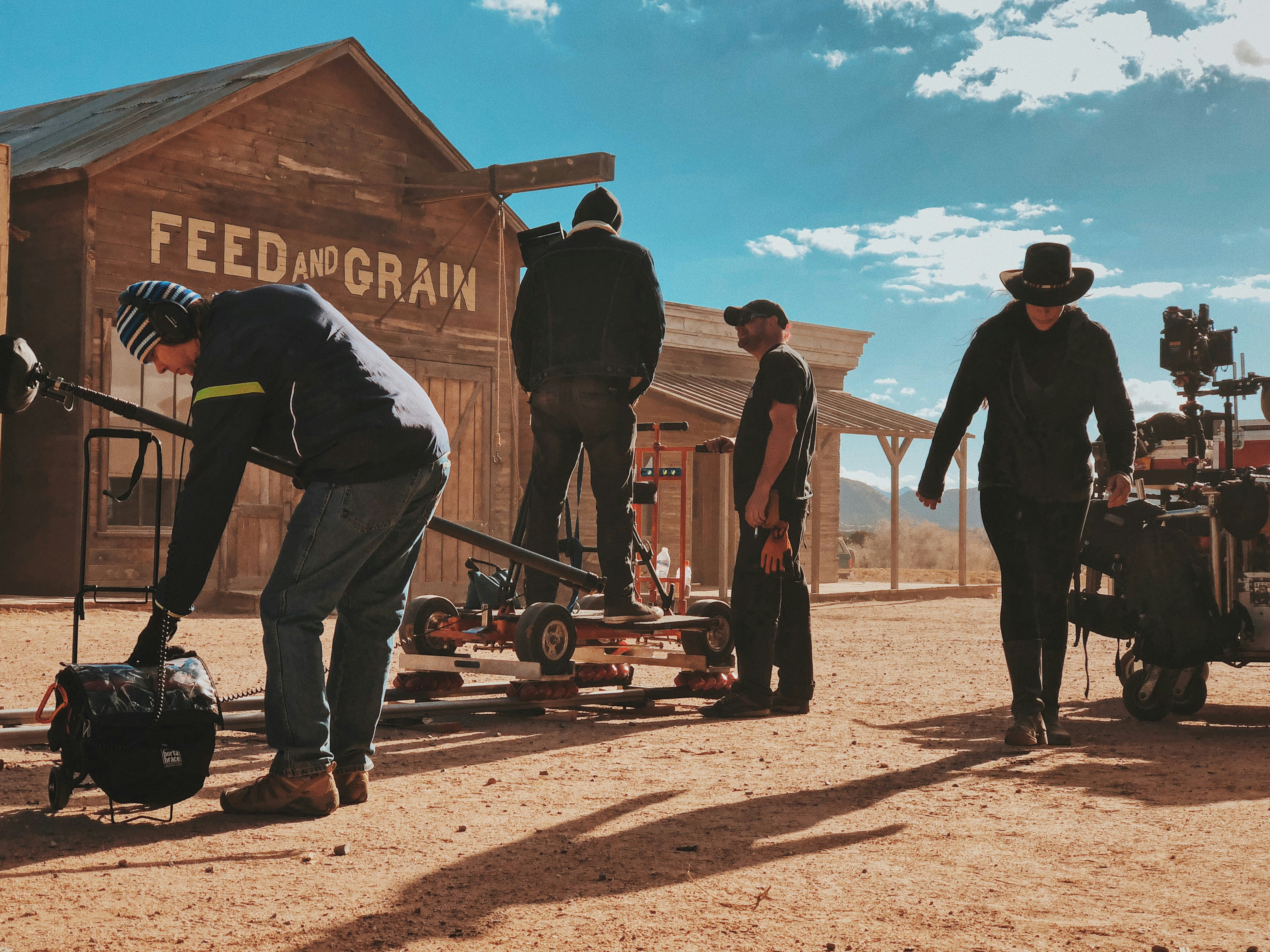Budgeting for an Independent Film: The Ultimate Guide
by WriteSeen
Navigating the nuances of budgeting for an independent film is often overwhelming, especially when every penny counts. Filmmakers face the dual challenge of maintaining financial discipline while staying true to their creative vision.
Our guide is designed to provide clarity and practical solutions, showcasing how others have succeeded on a shoestring budget.
- Mastering the essentials of budgeting for an independent film.
- Avoid common pitfalls by crafting a precise budget and staying flexible.
- Explore effective cost-cutting strategies without compromising on quality.
Understanding the Basics of Film Budgeting
Budgeting an independent film is your key to navigating the complex world of filmmaking with confidence. It's not just about numbers; it's about making calculated decisions that drive your creative vision forward. Film budgets map out your project's financial plan, ensuring every stage—from pre-production to post-production—is accounted for. Breaking down your script and allocating costs strategically is crucial.
Breaking Down the Budget Categories
- Pre-Production: This phase sets the foundation. You'll allocate funds for the script, location scouting, and planning logistics. Don't overlook this phase—solid preparation can save money later.
- Production: Here, the bulk of your budget goes. Think of costs related to the cast, crew, equipment, and locations.
- Post-Production: Editing, sound design, and visual effects fall under this category. Ensure you set aside enough resources to give your film the polish it deserves.
Avoid common budgeting pitfalls by anticipating marketing expenses. Learn from success stories like "Paranormal Activity," which turned a modest budget into massive success. By understanding these fundamentals, you’ll navigate the financial landscape effectively, ensuring your film is both artistic and financially viable.

How to Create an Accurate Film Budget
Creating a precise film budget hinges on understanding every expense, no matter how small. Start by breaking down your script scene-by-scene. This allows you to pinpoint every cost, from locations and props to actor fees. Knowing the ins and outs of every line item is your secret weapon.
Steps to Craft an Accurate Budget:
- Script Analysis: Outline each scene and identify resource needs. Locales, set requirements, and special effects play huge roles in cost. Time spent here pays off in smoother production.
- Data-Informed Estimates: Look at past indie projects similar in scale and style. Draw on this data to make realistic cost predictions. Add buffers—unexpected costs crop up.
- Flexibility: Software can keep you on track when things change. Adaptability is crucial. Embrace it. Gear breakdowns or actor swaps won't derail your project if you're prepared.
Budgeting software can simplify this process, providing templates and real-time updates. This ensures you're always on top of your budget, able to make informed decisions quickly. By doing this, you direct your resources where they are most needed, projects stay on track, and you avoid financial pitfalls.
Budgeting is more than balancing numbers. It’s about preparing for the unseen and adapting as you go.
With these techniques, you’ll approach budgeting not as a limitation, but as an enabler of creativity.
Key Components of a Film Budget
In crafting a film budget, understanding each component is vital for effective resource management. Let's dissect the primary elements to ensure you allocate effectively and cut costs smartly.
Primary Budget Components:
- Locations: Secure affordable spaces by utilizing public areas or negotiating private properties. Locations set the scene, so use creative licensing under official permits to economize without sacrificing vision.
- Talent and Crew: Opt for non-union actors to lower expenses, and have crew members like directors double as editors. Fresh-style actors save costs and provide valuable exposure to emerging talent.
- Equipment: Rent smartly, considering package deals or lower-rate seasons. Partnerships and rental agreements go a long way here.
- Permits and Insurance: Negotiate smartly by planning for location and shoot specifics ahead of time. These keep production running smoothly, free of legal hassles.
Every decision must serve your film’s success while keeping expenditures in check. Anticipate post-production outlays, knowing that creativity and strategy in tackling these components equips you for any financial hurdle.

Utilizing Funding Options for Independent Films
Securing funds for an indie film can seem daunting, but a variety of avenues can support your project financially. It's about creatively combining these options in a way that supports your narrative and taps into potential audiences.
Explore These Funding Sources:
- Crowdfunding: Platforms like Kickstarter allow you to not only fundraise but also build a community around your film. Engage supporters early and often. Leverage social media for wider reach.
- Grants: Look for grants about cultural or educational themes. These often provide funds without a monetary return requirement, aligning perfectly with inventive storytelling. Learn the ropes to write persuasive applications.
- Investors: Craft your pitch around a solid business plan. Present attractive ROI offers. Strong visuals and a clear vision often win investors' hearts. This route can provide ample funds, but requires meticulous planning.
- Government Incentives: Research local subsidies or tax credits. Matches between your film and localities boost your budget subtly, provided regional guidelines are met.
Creating an interactive fundraising campaign is crucial. Engage audiences with behind-the-scenes content and milestone updates. By strategically leveraging these funding options, you enhance your budget and strengthen your relationship with backers.
The Role of a Line Producer in Budgeting
The line producer is your financial guardian, overseeing the day-to-day operations while keeping a keen eye on the budget. Understanding their role provides insight into how every dollar is accounted for, ensuring your production stays on track.
Key Responsibilities:
- Daily Expense Monitoring: Line producers focus on daily cost assessments. They are the gatekeepers, cutting costs as necessary to keep the budget in check.
- Resource Allocation: They optimize resource uses, balancing creative needs with budget constraints. This includes hiring, scheduling, and logistics arrangements.
- Financial Tools: Equipped with financial planning software, line producers facilitate transparent budget tracking and adjustments. They maintain accurate daily records for continuous updates.
With a line producer, you have a skilled partner navigating the complexities of film production. They support your creative pursuits with a financial strategy that ensures everything stays on course. Their expertise in budgeting and resource management can make the difference between success and setbacks.

Exploring Funding Options for Independent Films
Funding is the lifeblood of your indie film. Without it, your script remains a dream on paper. Let's dive into funding sources and strategies that can elevate your film from idea to reality.
Diverse Funding Sources
When it comes to securing funds, diversity is key. You'll want to explore multiple avenues to ensure financial stability throughout the production.
- Crowdfunding: This isn’t just about asking for money. Connect with your future audience. Platforms like Kickstarter or Indiegogo let you share your vision directly with potential backers. Craft a compelling story and offer unique rewards to create a sense of community and investment in your film's success.
- Grants: Focus on narrative-driven projects or those with societal impacts. Research grants that align with your film’s themes. Securing a grant can provide not just funds but also credibility, which is invaluable in the industry.
- Investors: Make your project attractive with a solid business plan. Present clear profit opportunities. Your passion and clarity can win over investors who are hungry for fresh stories with potential returns.
- Tax Incentives: Explore tax credits offered by local governments or film commissions. These incentives can cushion your budget significantly, provided your project aligns with local filming policies.
Having multiple financial streams multiplies your chances of success. Combine them strategically to generate a more robust budget. This approach ensures you're not solely reliant on one source, reducing financial risk.
Utilizing Modern Tech Tools for Budget Management
Navigating film budgeting can seem like a labyrinth. Here's the kicker—you don't have to do it all alone. Modern tech tools are here to declutter the process, offering efficiency and streamlined communication among your team.
Advantages of Tech Tools
By integrating the right software into your workflow, you enhance accuracy and save time. These tools can offer numerous benefits:
- Movie Magic Budgeting: This tool caters specifically to filmmakers. Its templates cover comprehensive aspects of film production, ensuring no detail is overlooked. Such precision can make tracking and updating budgets far less daunting.
- Cloud Collaboration Platforms: Real-time updates and data sharing keep everyone on the same page. This kind of synergy saves time and reduces errors, which can be costly.
- Apps for Financial Tracking: Consider platforms like QuickBooks for financial oversight and budgeting apps designed for filmmaking. They offer insights into spending patterns, helping you identify areas for cost-saving.
By embracing technology, you allow yourself the bandwidth to focus on what matters—bringing your creative vision to life. These tools drive efficiency, freeing up precious time and resources for your craft.

Cost-Cutting Strategies Without Compromising Quality
Balancing cost with quality might seem like walking a tightrope. But effective strategies help you manage this equilibrium without sacrificing your film’s integrity. Let’s explore how you can trim costs while still producing a standout piece.
Effective Cost-Cutting Measures
No one wants a final product that's penny-pinched. Here are ways to maintain your film's sheen without overspending:
- Smart Scheduling: Avoid peak production times. Shooting off-season can result in lower travel, location, and equipment rental costs without compromising on quality.
- Bundle Rentals: Combine equipment hires through package deals. One vendor for cameras, lights, and sound gear means discounts and less logistical hassle.
- Minimize Locations: Fewer location changes reduce costs significantly. Use versatile settings to mimic multiple environments, stretching your dollar impressively.
- Local Talent and Resources: Aim to hire local actors and crew. This strategy reduces travel expenses and logistical complexities, plus it often adds authenticity to your production.
Strategic planning and creativity allow you to find the right balance between saving money and maintaining high production standards. These approaches ensure your film shines without breaking the bank.
Preparing for Contingencies in Film Budgeting
In the volatile world of filmmaking, surprises are not a question of "if," but "when." That's where a well-planned contingency fund comes into play. Let’s talk about why you need one and how to manage it effectively.
Crafting a Reliable Contingency Plan
Planning for the unexpected is essential. Proper contingencies safeguard against unforeseen expenditures:
- Set Aside a Percentage: Allocate 5–10% of your budget to contingencies. This creates a cushion for emergencies such as reshoots or unexpected location changes.
- Regular Check-Ins: Conduct frequent budget assessments to adjust your contingency plan as needed. This ensures you are responsive to shifting demands and unforeseen costs.
- Learn from the Past: Review case studies from other indie films to learn how they managed unexpected challenges. These insights help refine your approach and strengthen your strategy.
An effective contingency plan keeps disruptions manageable and maintains your project's momentum. With foresight and flexibility, you ensure that creative risks don't become financial burdens.
Conclusion
Throughout your journey in independent filmmaking, budgeting strategies are your anchor. Funding diversification, embracing modern tools, and strategic cost management set the stage for success. Combine this with thoughtful contingency planning and you have a roadmap to not just survive, but thrive in the competitive film landscape.